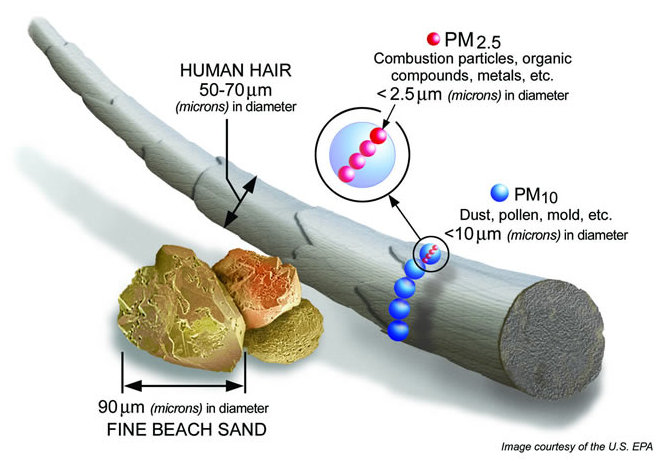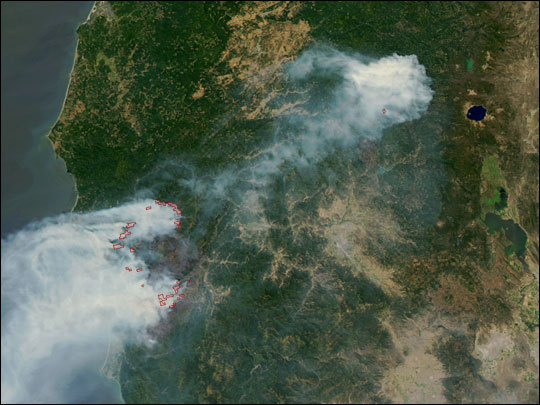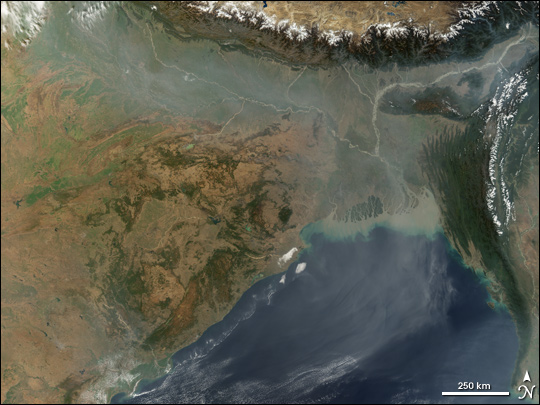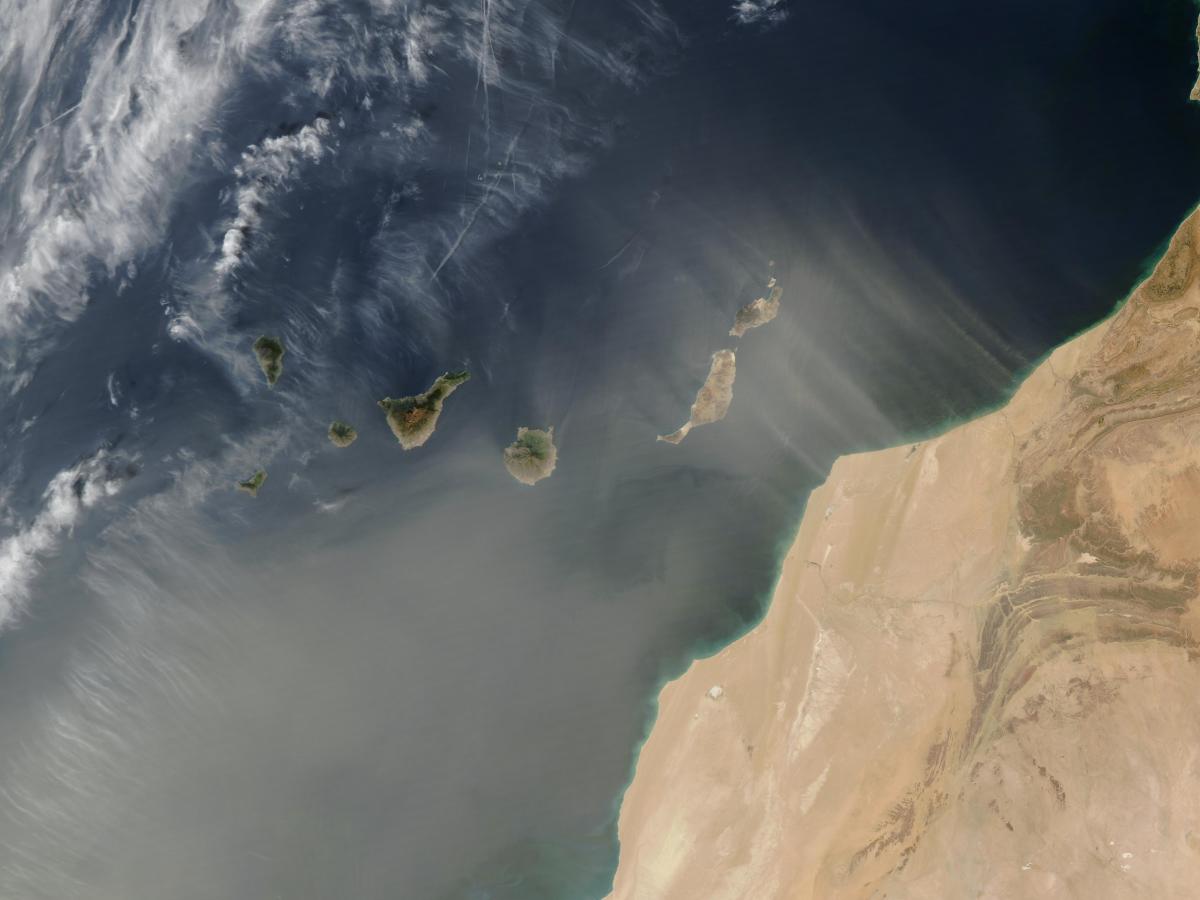Aerosols are defined as fine particles of solid or liquid suspended in a gas. For our purposes we are interested in the solid particles suspended in the atmosphere.
Aerosols come from both natural sources such as dust, sea salt, and volcanoes and man-made sources such as automobile and power plant emissions. Another term for man-made or man-caused is anthropogenic. Forest fires and crop burning, also known as biomass burning, can be natural and/or anthropogenic.
We are interest in studying Aerosols because of their effects on:
1. Climate
2. Weather
3. Human Health
4. Ecosystem Fertilization
We want to study aerosols from space since this is the most effective way to obtain a global understanding of their effects on climate, health and weather.
Aerosols as seen from space: smoke (left), smog (center) and dust (right)
Aerosols and Climate
One reason we study aerosols is to understand their role and influence on the Earth's climate. When we want to examine how the Earth's atmosphere warms and/or cools we talk about the earth's energy budget. We typically analyze this in terms of how incoming solar radiation interacts with various components of the atmosphere. For the most part this interaction results in a balanced state that is fairly stable. Events can occur, both natural and anthropogenic, to change this balanced state so that the atmosphere is either warming or cooling. When the warming or cooling is due to a change in the interaction of the incoming solar radiation with the Earth's ecosystem we refer to this as radiative forcing. For a more detailed treatment of this subject on an easy to read level see the wikipedia article on radiative forcing.
How incoming solar radiation interacts with various atmospheric components and their outcomes are depicted in very approximate amounts in the following graphic:

Above: A simplified graphic representation of how incoming solar radiation interacts with the Earth's atmosphere and surface.
However there is much about these processes we need to understand more precisely to really be able to assess climate forcing and potential climate change. The graphic below is based on work from the Intergovernmental Panel on Climate Chage (IPCC) Working Group I Fourth Assessment Report Summary for Policymakers. Shown below is their attempt to assess more precisely the contribution of various factors to radiative forcing. Each of the colored bars in the graphic expresses the contribution of the individual components to radiative forcing while the bar at the far right is a summary of the factors contributing to anthropogenic climate forcing. Positive values indicate a warming effect and negative values a cooling effect. At the end of each colored bar is a gray line which estimates the degree of uncertainty of the individual component. Notice that the two components with the largest uncertainty are both associated with aerosols!

Graphic by Leland McInnes, CC BY-SA 3.0, https://commons.wikimedia.org/w/index.php?curid=2501966
The Uncertainty in the Effects of Aerosols on Forcing and Climate
Locally aerosols may act to warm or cool the atmosphere although on a global basis their net effect is to cool the climate. There are effects based on aerosols' direct interaction with incoming solar radiation as well as indirect effects.
Direct effects happen when the aerosols scatter, absorb, or reflect the incoming solar radiation. Direct radiative cooling or warming due to aerosols will depend many factors including their total amount in the atmospheric column, where they are located in the atmospheric column (i.e. high or low in the atmosphere or evenly dispersed), and their color, shape and chemical composition Their net warming or cooling effect may also depend on what kind of surface is below them on the ground.
Indirect effects occur through aerosol interactions with clouds which may change thier properties such as how and where they form, their rate of precipitation, whether they are populated by ice or water crystals.
For a detailed scientific treatment of direct and indirect aerosol radiative forcing you can refer to 2023 IPCC climate report
Aerosols and Weather
Just as aerosols can affect clouds and cloud processes globally they can certainly act globally in a way that can affect local weather patterns. There are many well studied regional interactions between aerosol production, cloud formation and cloud properties. Examples include biomass burning in the rain forests of Brazil, urban pollution in China, and pollution effects on the South-Asian monsoon. These effects can manifest as reduced or increased rainfall or shifting rainfall amounts from one region to another. Sometimes these can affect global weather patterns. A web page summary of a recent publication from researchers at Texas A&M University and the University of Arizona explains some of the details of different aerosol types and how they can interact with clouds.
Aerosols and Human Health
We study aerosols to understand their effects on human health.
Aerosols which are small enough to penetrate deeply into the lungs when we breath can cause a huge array of diseases and even death. According to the Health Effects Institute "Air pollution is linked to illness and early death and is the fourth leading risk factor globally". You can explore the health effects of aerosols at https://www.stateofglobalair.org/
In the realm of human health we usually speak of aerosols as "particulate matter". Atmospheric particulates which can penetrate into the lungs are collectively referred to as PM 2.5 which means particles of diameter less than 2.5 microns in diameter.

We want to know where PM2.5 occurs and in what quantities near the earth's surface where people will be affected. This presents many challenges for space observations principally because remote sensing satellites measure the total column amount of aerosols. Translating this to the amount near the surface typically requires additional information from ground based sensors and models.



